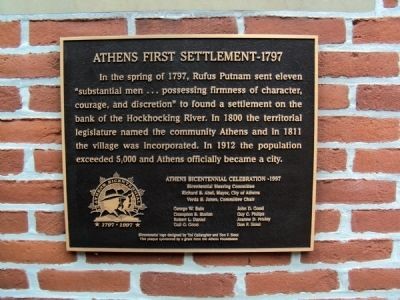Athens First Settlement Plaque, 1797-1997
Introduction
Text-to-speech Audio
Created as part of the city's bicentennial celebration, this plaque on the wall of the Athens City Building commemorates the arrival of the first settlers of European descent to the banks of the Hockhocking River in 1797. In 1800, their settlement became known as Athens, and in 1811, the village was incorporated. It was another hundred years before the village population increased to that of a city.
Images
This plaque was dedicated in 1997 and is located to the left of the main door to the Athens City Building.

Backstory and Context
Text-to-speech Audio
Prior to European settlement, this area was home to nomadic hunter-gatherers that established temporary settlements throughout the valley. Around 1000 BCE, those settlements became more permanent as these native inhabitants began cultivating crops from seeds and returning to the area. Agriculture allowed the population of these bands to expand, leading to the creation of permanent settlements and even villages. Archaeologists refer to these various groups that lived in this are from 1000 BCE to about 200 AD as members of the "Adena" culture.
The term "Adena" refers to a time period and area of settlement, as well as a few common traits rather than a specific tribe or band. In fact, the name Adena comes not from records or oral histories passed down from descendants of these early settlers, but from the name of former Ohio Governor's estate in Chillicothe. Relatively little is known about these early settlers beyond what researchers can discover and discern from artifacts that have been found throughout the Ohio Valley.
The first settlers of European descent came to the banks of the Hockhocking River in 1797. Three years later, the territorial legislature of Ohio named the settlement Athens. Ohio University began its first semester in 1809, and the village of Athens was incorporated two years later. Ohio University originally offered courses that were intended to prepare rural teachers and reflected more of a high school curriculum. By 1922, the institution had grown and could offer a full slate of collegiate courses. The town itself grew much more slowly, with only 710 residents in 1840 and a population of less than 2,500 prior to 1880. It took a century for the village to reach a population of five thousand, and after reaching that benchmark in 1912, the village officially became a city. Today, more than 28,000 students attend Ohio University.
Sources
Athens Ohio, from Ohio History Central http://www.ohiohistorycentral.org/w/Athens,_Ohio?rec=1894 accessed 8/29/15
